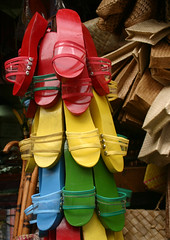"Fashioned from light wood initially with the use of the bandsaw, bakya was afterwards smoothly shaved, and carved with floral, geometric or landscape design, then painted or varnished to a high sheen in the distinctive Paete style. Uppers made of clear plastic or thin rubber were then fastened to the sides with tiny nails ("clavitos") and the bakya was ready for export.
In its heyday (1930s to 1950s), American tourists and soldiers bought bakya as souvenirs for their girlfriends and mothers. But for Filipinos, bakya was the footwear for all seasons. You wore them in water or on land. Bakya was easy to get in and out of, which made it convenient for use by people who wore them on the ground but took them off when climbing upstairs into their houses. My mother, Laureana Cajipe, used to say that you could tell how well-mannered a person was by the way he left behind his bakya before entering the house, "Kabastusan yung iiwanan mo ang bakya mo na nakahakbang!"
When I was growing up in the early 50s, bakya shops were veritable channels of Paete culture where apprentices were trained, families worked closely together, traditional songs and poems were passed on to the young, friendships were forged and romances blossomed. Bakya was Paete's rice-and-fish. The industry that fed, clothed, and sheltered us also taught us responsibility and gave us wisdom. It nurtured our dreams and led us to believe that we would grow up to become good people, just like our parents. And Paete prospered.
- from Marie Cagahastian Pruden's "Romancing the Bakya"
2008-01-14
The Bakya
Subscribe to:
Post Comments (Atom)

No comments:
Post a Comment